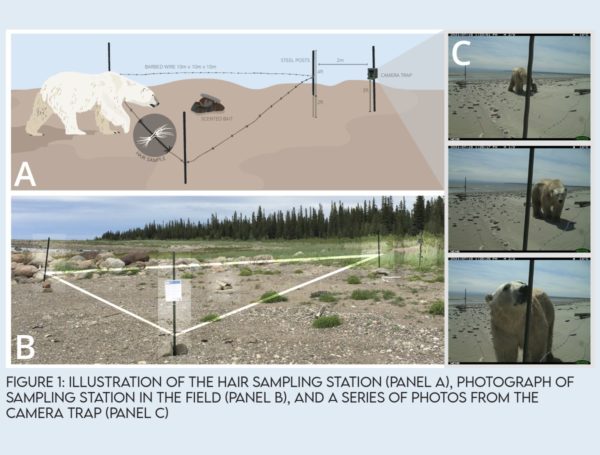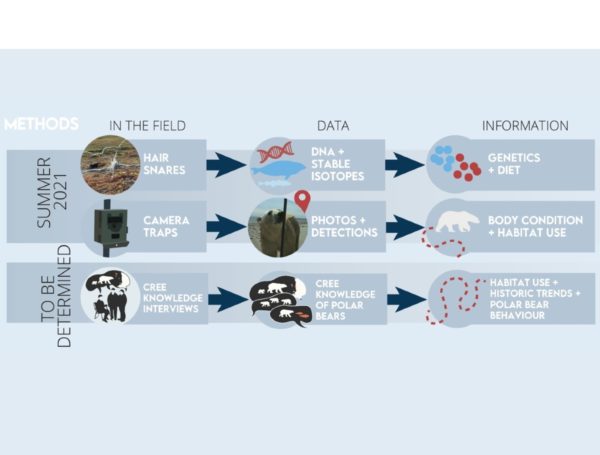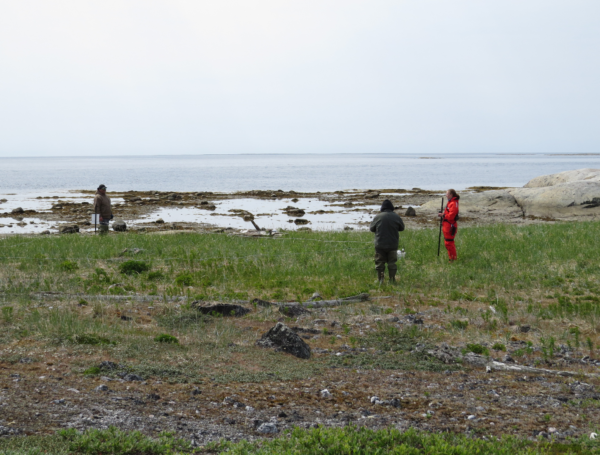Case Studies
Case Study 6: Monitoring Polar Bears in the Eeyou Marine Region (James Bay, Canada) with Cameras and Hair Samples Monitoring James Bay Polar
Case Study 6: Monitoring Polar Bears in the Eeyou Marine Region (James Bay, Canada) with Cameras and Hair Samples Monitoring James Bay Polar
Polar bears are important arctic predators that can have large impacts on the plant, animal, and human communities around them. Globally, they are threatened by climate change and reductions in their critical habitat, sea ice. At the southern edge of their range, the polar bears in James Bay and the Eeyou Marine Region (EMR) are particularly vulnerable to warming conditions, but little information is available about their population composition, health, behaviour, or diet. In consultations with the coastal Cree communities in Eeyou Istchee, polar bears were identified as a high research priority following local observations of changes in polar bear abundance and movements.
Update on the Polar Bear Ecology in the Eeyou Marine Region research project featuring Alexandra Langwieder, Natasha Louttit, George Natawapineskum, Henry Stewart, and Ernie Hughboy.
To collect baseline information on the polar bears in the EMR, a field-based polar bear research program was launched in partnership between the Eeyou Marine Region Wildlife Board, the Regional Cree Trappers’ Association, the communities of Waskaganish, Eastmain, Wemindji and Chisasibi, and researchers from McGill University (Dr. Murray Humphries and PhD student Alexandra Langwieder). The team is using non-invasive hair snare and camera trap sampling methods to gather information about polar bear genetics, diet, body condition and habitat use. Hair snares use barbed wire strung on posts around a scented bait to capture hair samples from an animal. As the animal passes over the wire to investigate the bait, hair gets caught in the wire and then field teams come to collect the sample later. While this is happening, a camera trap takes photos of the animal to gather information about its body condition. In 2021, project lead Alexandra Langwieder and 4 Cree community field teams deployed 37 hair snare and camera trap sampling stations across 400km of the EMR in James Bay. Through this they gathered 138 polar bear observations and 118 polar bear hair samples, which will be used to answer questions about genetics, diet, habitat use, and body condition.
Discrepancies between northern community and research scientist assessments of polar bear populations are an ongoing challenge in Canadian polar bear research. As such, another focus of this project is to ensure the objectives, study design, and any outcomes are founded on both Western science and Cree Knowledge as well as on shared priorities and concerns about the research process. The project began with conversations between regional Cree wildlife organizations and McGill researchers to determine how to collectively address local research priorities. Cree Knowledge has been a key part of the project’s development and informs all stages of the research. Field data collection and logistics are led by Cree community field teams and interviews with community members are scheduled for fall 2022. Interviews will document community observations and knowledge related to polar bear ecology, the importance of polar bears in the James Bay ecosystem, and any changes that have been observed over time. Through this project, the team aims to challenge the significant underrepresentation of Indigenous Peoples in polar bear research and conservation despite their longstanding relationship and co-existence with this species.


Figures from EMRWB Research Fund 2021-2022 REPORT: Investigating Polar Bear Ecology in the Eeyou Marine Region by Alexandra Langwieder.
Accessed at: https://www.emrwb.ca/polar-bear-ecology/
This project has also provided an opportunity for community members to play a leading role in polar bear research by developing and implementing monitoring tools in the field. In each community, a team of experts is trained in camera trap and hair snare sampling methods and, if communities are interested, this project may be continued indefinitely as a long-term monitoring program. The information collected will inform communities about areas of high polar bear activity on the land as well as the population health of the polar bears in the EMR. After the hair samples are analyzed in the lab, communities will know how many individuals were detected at the sampling locations and what kind of diet they have. These methods can also be applied to study other species in the EMR and camera trap photos from the polar bear project are already being used to track caribou, goose, and black bear distributions. This has provided previously unknown information about species use of islands in the region.

Members of the research team setting up cameras and hair snares.




